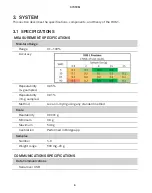
3
ROS 1
Table 1 Installation (continued)
Calibration
Calibrate the Scale
Navigate to the Settings menu in the Bridge app.
Click on the
Calibrate Scale button from the Settings menu.Follow the prompts
to complete the calibration.
contains more details about calibrating
the scale.
To print a certificate of calibration, click the
Generate Calibration Certificate
button from the Settings menu.
WARNING: The 2.0000-g standard weight must be handled only with clean lab utensils
such as tweezers. Mishandling the standard weight nullifies the calibration.
2.2 SAMPLE PREPARATION
Proper sample preparation is important to keep the ROS 1 clean and achieve repeatable
results. Carefully prepare and load samples to lengthen time between ROS 1 cleanings
and to help avoid downtime. Be consistent in sample preparation methods (e.g., crush,
grind, slice the sample) to obtain reproducible results. Exposure of samples to the ambient
atmosphere should be minimized since this will affect the measured moisture content.
Place a representative selection of the material in each cup. When adding the sample to the
cup, spread it out over the bottom of the cup as much as possible to ensure good contact
with the heating surface.
The nature of some samples results in longer reading times and may require additional
preparation to ensure accurate readings. Crush, slice, or blend coated or dried samples
before testing to increase the surface area of the sample, thus decreasing testing times.
Follow the steps listed below to prepare samples:
1. Make sure the sample to be measured is representative.
Multicomponent samples (e.g., muffins with raisins) or samples that have outside
coatings (like deep-fried, breaded foods) can be measured, but they need to have
representative portions in the cup. The moisture is not distributed uniformly among the
components, so getting an accurate moisture content depends on the operator’s ability
to choose a sample that accurately represents the product.
2. Place the sample in a disposable sample cup.
a. Completely cover the bottom of the cup, if possible.
The ROS 1 is also able to accurately measure a sample that does not (or cannot)
cover the bottom of the cup. For example, raisins only need to be placed in the cup
and do not need to be flattened to cover the bottom. A larger sample surface area
increases instrument efficiency by providing more area for evaporation per unit
sample volume. It also speeds up the reading by shortening the time needed for the
sample to get to its drying temperature.





















